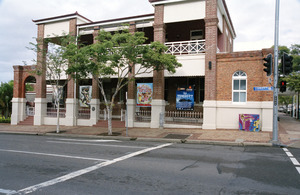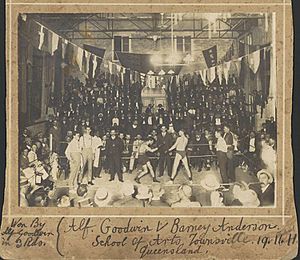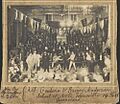Townsville School of Arts facts for kids
Quick facts for kids Townsville School of Arts |
|
|---|---|

Townsville School of Arts, 2005
|
|
| Location | Stanley Street, Townsville CBD, City of Townsville, Queensland, Australia |
| Design period | 1870s–1890s (late 19th century) |
| Built | 1891 |
| Architect | Eyre & Munro |
| Architectural style(s) | Classicism |
| Official name: Townsville School of Arts, Dance North, Townsville Arts Centre | |
| Type | state heritage (built) |
| Designated | 21 October 1992 |
| Reference no. | 600925 |
| Significant period |
|
| Significant components | School of Arts |
| Builders | James Smith |
| Lua error in Module:Location_map at line 420: attempt to index field 'wikibase' (a nil value). | |
The Townsville School of Arts building is a special historic place in Townsville, Queensland, Australia. It used to be a "school of arts," which was like a community learning center. Today, it's a busy cultural hub called the Dancenorth Theatre and Townsville Arts Centre. Famous architects Eyre & Munro designed it, and James Smith built it in 1891. This building is so important that it was added to the Queensland Heritage Register on October 21, 1992.
A Place for Learning and Fun
What Were Schools of Arts?
In the early 1800s, "Mechanics' Institutes" or "Schools of Arts" started in Britain. These places helped people learn and grow. They offered lectures, discussions, and libraries. This was important because public libraries were rare, and books were expensive.
The first School of Arts in Queensland began in Brisbane in 1849. Its goal was to help the community learn about literature, philosophy, and science. As towns grew, more Schools of Arts opened. They became key places for adults to continue their education. The government even helped by providing land and money for books and buildings. Many Schools of Arts also had a hall with a stage. This encouraged arts and helped them earn money.
Early Days in Townsville
The first School of Arts committee in Townsville met in 1866. Important citizens, like the town's founders Captain Robert Towns and John Melton Black, were part of it. Townsville was a new port and business center at the time.
The School of Arts started small, in a rented cottage with only 30 books. It soon moved to bigger places. In 1877, it got its own building on Melton Hill. However, the town's main business area moved west. By 1889, people felt the School of Arts was too far away.
A New Building for the Community
The Melton Hill property was sold to the Queensland Government. It was turned into a court building. A new spot was bought at Stanley and Walker Streets. A competition was held to design the new building. Eyre and Munro, architects from Townsville, won.
Walter Eyre was an architect, engineer, and surveyor. He trained in England and came to Brisbane in 1880. He later became Townsville's City Engineer. In 1887, he started his own architecture business. WHA Munro joined him as a junior partner. Their firm designed many important buildings in North Queensland.
Local builder James Smith constructed their design for the School of Arts. The new building opened in May 1891. It had a debutante ball on opening night and a concert soon after.
What Was Inside?
The new building had meeting rooms and classrooms on the ground floor. A large library was upstairs. Classes taught subjects like drawing, singing, and woodwork. In 1895, the first gas cooking classes in Townsville were held here.
A theatre building, originally called Her Majesty's, was connected to the School of Arts. It could seat 600 people. This large space had a stage with dressing rooms on the sides. Many traveling theatre groups and performers used it. Even a Chinese Opera company performed there in 1894. Famous singer Nellie Melba appeared there in 1909.
The theatre was later renamed His Majesty's. In 1907, it hosted the first Aboriginal stage performance in Townsville. A variety company formed by local Aboriginal people performed there. Boxing matches were also held in the theatre.
Facing Challenges
The building was damaged by cyclones. Cyclone Sigma hit in 1896, and Cyclone Leonta in 1903. The offices lost their roof, and the theatre was partly destroyed. Repairs were made in 1904 by architects Tunbridge and Tunbridge.
It became clear the theatre was too small. In 1913, the auditorium was made bigger. An extension was added at the Walker Street end.
During the Great Depression, many Schools of Arts closed. This was because the government stopped giving them money. The Townsville School of Arts stayed open until the 1930s. Verandahs were enclosed, and a small office building was added between 1929 and 1934.
New ways to learn and have fun appeared. Also, the Libraries Act of 1943 made free lending libraries possible. These changes led to most Schools of Arts closing.
A New Chapter
In 1938, the School of Arts Trustees gave the building to the Townsville City Council. This created Australia's first free public lending library.
In 1941, during World War II, the military took over the building. It became the main Royal Australian Air Force (RAAF) postal office for the Pacific region. After the war, it became offices for the Townsville Regional Electricity Board. They moved out in 1963. The Northern Electricity Authority then used the building until 1968. After that, the building was empty for some time.
In the late 1960s, the Townsville Arts Centre Association formed. In 1976, the building was greatly renovated. It became an arts center. It housed the Pacific Festival office and was a base for the Townsville Little Theatre and a community radio station, 4TTT. Today, it is home to Dancenorth, a well-known dance company. More work was done in the 1990s, including putting the upper verandah back.
As of 2025, the building is known as the SOA (School of Arts) Theatre. It continues to be a vibrant home for Dancenorth.
Building Features
The Townsville School of Arts building is at the corner of Stanley and Walker Streets. It has a two-storey main building. An attached theatre building runs behind it. You can enter the theatre from Walker Street or from inside the main building.
Both buildings are made of exposed brick. Their roofs are corrugated iron. The main School of Arts building has two storeys. On the Stanley Street side, it has brick columns that go up both floors. These columns create deep verandahs. The ground floor verandah has low steps, decorative iron railings, and matching gates. The main entrance has double doors with windows on either side.
The upper floor verandah has timber balustrading. French doors with windows above them lead to this verandah. The ground floor has offices, toilets, lobbies, and the main entrance area. A timber staircase leads from the entrance to the first floor. This floor is divided into two parts by an arch. It is used as a dance space.
A single-storey brick extension is at the corner of Stanley and Walker Streets. It looks similar to the main building. On the other side of the Stanley Street front, a brick arch leads to a passageway.
The theatre is a large rectangular building. Outside, it has shallow brick pillars. There is an entrance on Walker Street. The back has large doors, designed for moving scenery and props. Inside, there is a large auditorium with a timber floor and a stage area. The stage has a basement underneath.
On the north side, a 1960s brick building was added for dressing rooms. This area has been updated for performers. On the south side, an extension runs along the building. It houses the studios and offices for the 4TTT radio station.
Why It's a Heritage Site
The Townsville School of Arts was added to the Queensland Heritage Register on October 21, 1992. This means it's a very important historical place.
Showing Queensland's History
This building shows how Schools of Arts helped towns grow in Queensland. Its size and design show how wealthy and important Townsville was back then. Schools of Arts were community centers. They helped spread information and provided places for talks, meetings, and events like balls, plays, and concerts. They were a key part of adult education in Queensland.
A Great Example of Its Kind
It is a good example of a School of Arts building in a major city. It originally had a library, meeting rooms, and a theatre. These facilities supported many community and cultural events.
Beautiful and Important
The Townsville School of Arts is a well-designed and noticeable building. It adds a lot to the look of Townsville. Its shape, size, materials, and location near the town center make it very important.
Special to the Community
The School of Arts building has a strong connection with the people of Townsville. It has been a big part of the town's social and community life for many years.
Linked to Important People
This building is a major work by the North Queensland architectural firm of Eyre and Munro. Their work is important in Queensland's history.
Images for kids




